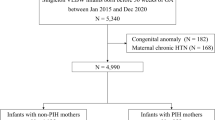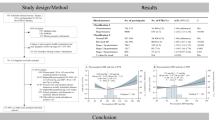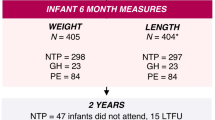Abstract
Maternal hypertension and preeclampsia are associated with greater risk of hypertension in childhood, and cardiovascular events in adulthood. However, whether preeclampsia affects blood pressure (BP) in the newborn period is unclear. Previous neonatal studies were based on small sample sizes, very low birth weight or gestational age or limited duration (h). To delineate hemodynamic repercussions of maternal preeclampsia on preterm infants (gestational ages ⩾29 weeks) with/without intrauterine growth restriction (IUGR) in the first 3 postnatal days, we conducted a single-centre retrospective cohort study of singleton births at 29–35 weeks of gestation in Montreal, Canada, from 2008 to 2011. Data were obtained from medical charts. Exclusion criteria included congenital anomalies, infections, pre-pregnancy maternal hypertension and gestational diabetes. IUGR was defined as birth weight <10th percentile. Of the 338 eligible neonates, 230 were included: 75 preeclampsia-IUGR, 72 preeclampsia-only and 83 controls. The preeclampsia-IUGR group had longer gestations than the preeclampsia-only or control groups (32.4±1.8 vs 31.3±1.6 vs 31.7±1.6 weeks, respectively; P<0.001). Mean BPs increased over the first 3 days for all newborns (P<0.001). Infants with preeclampsia-associated IUGR had the highest systolic and diastolic BPs, even after adjustment for birth weight, and preeclampsia-only the next highest. Systolic BP progression showed significant differences between groups (P<0.05). We conclude that impact of preeclampsia on children blood pressure was manifest within days of birth, over and above coexisting IUGR. Long-term cardiovascular follow-up and targeted preventive strategies are advised for this underrecognized high-risk population.
This is a preview of subscription content, access via your institution
Access options
Subscribe to this journal
Receive 12 digital issues and online access to articles
$119.00 per year
only $9.92 per issue
Buy this article
- Purchase on Springer Link
- Instant access to full article PDF
Prices may be subject to local taxes which are calculated during checkout



Similar content being viewed by others
References
Hutcheon JA, Lisonkova S, Joseph KS . Epidemiology of pre-eclampsia and the other hypertensive disorders of pregnancy. Best Pract Res Clin Obstet Gynaecol 2011; 25 (4): 391–403.
Higgins M, Keller J, Moore F, Ostrander L, Metzner H, Stock L . Studies of blood pressure in Tecumseh, Michigan. I. Blood pressure in young people and its relationship to personal and familial characteristics and complications of pregnancy in mothers. Am J Epidemiol 1980; 111 (2): 142–155.
Langford HG, Watson RL . Prepregnant blood pressure, hypertension during pregnancy, and later blood pressure of mothers and offspring. Hypertension 1980; 2 (4 Pt 2): 130–133.
Palti H, Rothschild E . Blood pressure and growth at 6 years of age among offsprings of mothers with hypertension of pregnancy. Early Hum Dev 1989; 19 (4): 263–269.
Seidman DS, Laor A, Gale R, Stevenson DK, Mashiach S, Danon YL . Pre-eclampsia and offspring’s blood pressure, cognitive ability and physical development at 17-years-of-age. Br J Obstet Gynaecol 1991; 98 (10): 1009–1014.
Tenhola S, Rahiala E, Halonen P, Vanninen E, Voutilainen R . Maternal preeclampsia predicts elevated blood pressure in 12-year-old children: evaluation by ambulatory blood pressure monitoring. Pediatr Res 2006; 59 (2): 320–324.
Lazdam M, de la Horra A, Pitcher A, Mannie Z, Diesch J, Trevitt C et al. Elevated blood pressure in offspring born premature to hypertensive pregnancy: is endothelial dysfunction the underlying vascular mechanism? Hypertension 2010; 56 (1): 159–165.
Kajantie E, Eriksson JG, Osmond C, Thornburg K, Barker DJ . Pre-eclampsia is associated with increased risk of stroke in the adult offspring: the Helsinki birth cohort study. Stroke 2009; 40 (4): 1176–1180.
Miller FC, Read JA, Cabal L, Siassi B . Heart rate and blood pressure in infants of pre-eclamptic mothers during the first hour of life. Crit Care Med 1983; 11 (7): 532–535.
Hegyi T, Carbone MT, Anwar M, Ostfeld B, Hiatt M, Koons A et al. Blood pressure ranges in premature infants. I. The first hours of life. J Pediatr 1994; 124 (4): 627–633.
Hegyi T, Anwar M, Carbone MT, Ostfeld B, Hiatt M, Koons A et al. Blood pressure ranges in premature infants: II. The first week of life. Pediatrics 1996; 97 (3): 336–342.
Swarup J, Balkundi D, Sobchak Brozanski B, Roberts JM, Yanowitz TD . Effect of preeclampsia on blood pressure in newborn very low birth weight infants. Hypertens Pregnancy 2005; 24 (3): 223–234.
Teng RJ, Wu TJ, Sharma R, Garrison RD, Hudak ML . Early neonatal hypotension in premature infants born to preeclamptic mothers. J Perinatol 2006; 26 (8): 471–475.
Versmold HT, Kitterman JA, Phibbs RH, Gregory GA, Tooley WH . Aortic blood pressure during the first 12 hours of life in infants with birth weight 610 to 4,220 grams. Pediatrics 1981; 67 (5): 607–613.
Zubrow AB, Hulman S, Kushner H, Falkner B . Determinants of blood pressure in infants admitted to neonatal intensive care units: a prospective multicenter study. Philadelphia Neonatal Blood Pressure Study Group. J Perinatol 1995; 15 (6): 470–479.
Davis EF, Newton L, Lewandowski AJ, Lazdam M, Kelly BA, Kyriakou T et al. Pre-eclampsia and offspring cardiovascular health: mechanistic insights from experimental studies. Clin Sci (Lond) 2012; 123 (2): 53–72.
Kramer MS, Platt RW, Wen SW, Joseph KS, Allen A, Abrahamowicz M et al. A new and improved population-based Canadian reference for birth weight for gestational age. Pediatrics 2001; 108 (2): E35.
Magee LA, Helewa M, Moutquin JM, von DP . Diagnosis, evaluation, and management of the hypertensive disorders of pregnancy. J Obstet Gynaecol Can 2008; 30 (3 Suppl): S1–48.
Spinazzola RM, Harper RG, de Soler M, Lesser M . Blood pressure values in 500- to 750-gram birthweight infants in the first week of life. J Perinatol 1991; 11 (2): 147–151.
Cordero L, Giannone PJ, Rich JT . Mean arterial pressure in very low birth weight (801 to 1500 g) concordant and discordant twins during the first day of life. J Perinatol 2003; 23 (7): 545–551.
LeFlore JL, Engle WD, Rosenfeld CR . Determinants of blood pressure in very low birth weight neonates: lack of effect of antenatal steroids. Early Hum Dev 2000; 59 (1): 37–50.
Riaz M, Porat R, Brodsky NL, Hurt H . The effects of maternal magnesium sulfate treatment on newborns: a prospective controlled study. J Perinatol 1998; 18 (6 Pt 1): 449–454.
Abbassi-Ghanavati M, Alexander JM, McIntire DD, Savani RC, Leveno KJ . Neonatal effects of magnesium sulfate given to the mother. Am J Perinatol 2012; 29 (10): 795–799.
Kent AL, Chaudhari T . Determinants of neonatal blood pressure. Curr Hypertens Rep 2013; 15 (5): 426–432.
Barker DJ, Osmond C, Golding J, Kuh D, Wadsworth ME . Growth in utero, blood pressure in childhood and adult life, and mortality from cardiovascular disease. BMJ 1989; 298 (6673): 564–567.
Rahiala E, Tenhola S, Vanninen E, Herrgard E, Tikanoja T, Martikainen A . Ambulatory blood pressure in 12-year-old children born small for gestational age. Hypertension 2002; 39 (4): 909–913.
Law CM, Shiell AW . Is blood pressure inversely related to birth weight? The strength of evidence from a systematic review of the literature. J Hypertens 1996; 14 (8): 935–941.
Law CM, de Swiet M, Osmond C, Fayers PM, Barker DJ, Cruddas AM et al. Initiation of hypertension in utero and its amplification throughout life. BMJ 1993; 306 (6869): 24–27.
Smal JC, Uiterwaal CS, Bruinse HW, Steendijk P, van Bel F . Inverse relationship between birth weight and blood pressure in growth-retarded but not in appropriate for gestational age infants during the first week of life. Neonatology 2009; 96 (2): 86–92.
Metz TD, Lynch AM, Wolfe P, Barry JS, Galan HL . Effect of small for gestational age on hemodynamic parameters in the neonatal period. J Matern Fetal Neonatal Med 2012; 25 (10): 2093–2097.
Himmelmann A, Svensson A, Hansson L . Relation of maternal blood pressure during pregnancy to birth weight and blood pressure in children. The Hypertension in Pregnancy Offspring Study. J Intern Med 1994; 235 (4): 347–352.
Nuyt AM . Mechanisms underlying developmental programming of elevated blood pressure and vascular dysfunction: evidence from human studies and experimental animal models. Clin Sci (Lond) 2008; 114 (1): 1–17.
Peyronnet J, Dalmaz Y, Ehrstrom M, Mamet J, Roux JC, Pequignot JM et al. Long-lasting adverse effects of prenatal hypoxia on developing autonomic nervous system and cardiovascular parameters in rats. Pflugers Arch 2002; 443 (5–6): 858–865.
Broughton Pipkin F, Smales OR . Proceedings: Blood pressure and angiotensin II in the newborn. Arch Dis Child 1975; 50 (4): 330.
Segar JL . Ontogeny of the arterial and cardiopulmonary baroreflex during fetal and postnatal life. Am J Physiol 1997; 273 (2 Pt 2): R457–R471.
Irani RA, Xia Y . The functional role of the renin-angiotensin system in pregnancy and preeclampsia. Placenta 2008; 29 (9): 763–771.
Wallukat G, Homuth V, Fischer T, Lindschau C, Horstkamp B, Jupner A et al. Patients with preeclampsia develop agonistic autoantibodies against the angiotensin AT1 receptor. J Clin Invest 1999; 103 (7): 945–952.
Zhou CC, Zhang Y, Irani RA, Zhang H, Mi T, Popek EJ et al. Angiotensin receptor agonistic autoantibodies induce pre-eclampsia in pregnant mice. Nat Med 2008; 14 (8): 855–862.
Herse F, Dechend R, Harsem NK, Wallukat G, Janke J, Qadri F et al. Dysregulation of the circulating and tissue-based renin-angiotensin system in preeclampsia. Hypertension 2007; 49 (3): 604–611.
Acknowledgements
We are grateful to Danielle Buch, medical writer/editor at the Applied Clinical Research Unit of the CHU Sainte-Justine Research Centre, for the English translation, critical revision and substantive editing/rewrites of the manuscript. Marianne Reveret was supported by a fellowship from the CHU Sainte-Justine Foundation. Ariane Boivin was supported by a fellowship from the Quebec Training Network in Perinatal Research (CIHR/FRSQ). Anne Monique Nuyt was supported by a salary award from the Fonds de la Recherche en Santé du Québec (FRSQ).
Author information
Authors and Affiliations
Corresponding author
Ethics declarations
Competing interests
The authors declare no conflict of interest.
Rights and permissions
About this article
Cite this article
Reveret, M., Boivin, A., Guigonnis, V. et al. Preeclampsia: effect on newborn blood pressure in the 3 days following preterm birth: a cohort study. J Hum Hypertens 29, 115–121 (2015). https://doi.org/10.1038/jhh.2014.50
Received:
Revised:
Accepted:
Published:
Issue Date:
DOI: https://doi.org/10.1038/jhh.2014.50
This article is cited by
-
Clinical outcomes of hypertensive disorders in pregnancy in the offspring during perinatal period, childhood, and adolescence
Journal of Human Hypertension (2021)
-
Adverse Pregnancy Conditions, Infertility, and Future Cardiovascular Risk: Implications for Mother and Child
Cardiovascular Drugs and Therapy (2015)



